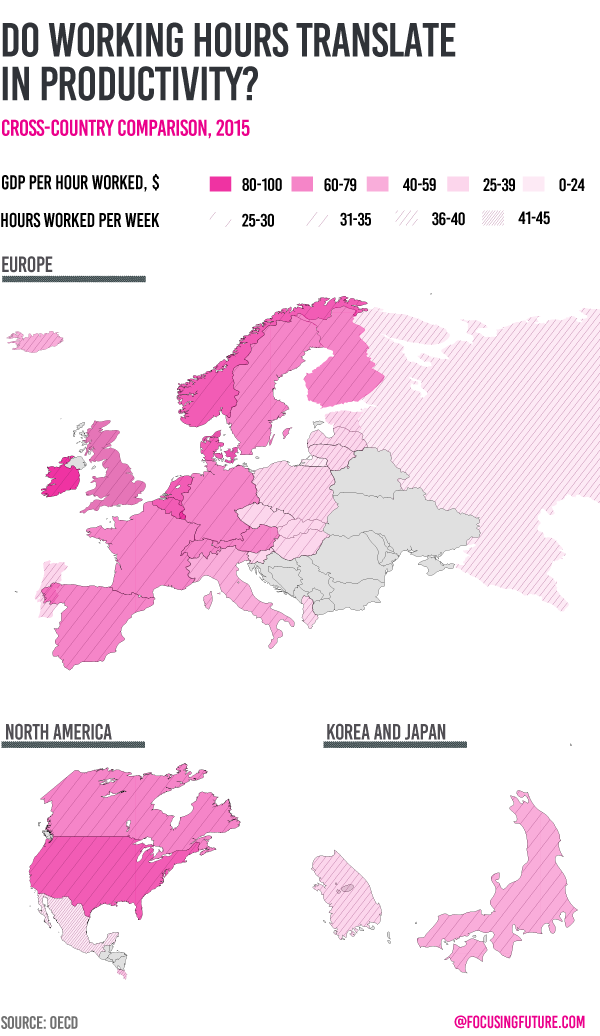![]() 6 minute read
6 minute read
Employers of tomorrow need to recognize how employees of today work. An efficient workforce of the future will encompass a global collection of employees who will provide critical feedback when and where needed. Also, as technology advances, the human workforce will be better managed leading to a healthier work-personal life balance. The article investigates the term of a liquid workforce and cross-country comparison of work productivity.
Skills over employment
Reflecting the market’s need for new know-how, the workplace of the future will be wholly dynamic. The working environment will be greatly altered to be more employee- and employer-friendly. The future of an ideal workplace will lie with a balance of these two. With time, both the workers and the companies have begun to realize the advantages of part-time work. Future needs of companies are already transforming their workforces. The HR fields are busy today in formulating a new employee-engagement framework which successfully borrows talents from part-time employees in an efficient manner. One such emphasis is to use part-timers. In 2016, 35% of U.S. workforce were freelancers, hitting 55 million workers. Using freelancers also allows companies to experiment initiatives before investing wholly into new recruits. This, according to Diane Domeyer, executive director of recruitment firm The Creative Group, are ideal choices for companies that risk laying off the employees if the demand for service decreases. This, in turn, has given in to the trend of a liquid workforce which emphasizes skills rather than employment. Such a workforce is more agile, flexible and mobile. Creative employees who would want to branch out their services to other projects, favour this new model due to the freedom it offers. However, trade unions worry that the non-standardized working models exploit employees and need to be regulated.
Technology enables
vocational education
The solution to finding balance according to Pellavi Ferma, Accenture’s senior managing director, lies with integrating technology to monitor work and to motivate employees across the board. Data analytics or work commitments, their individual behaviour traits, personality types and their personal needs and commitments can result in a healthier working relationship. Moreover, employees must be updated with training and courses to ensure their relevance to the companies. Online courses are seen to be the most efficient way forward for such training. LinkedIn foresees this and has hence acquired Lynda.com. According to Accenture, on-job learning would become so important that corporate education will replace higher education. In this way, the workforce will remain liquid; open to skill-acquisition and well-placed in line with the needs of employees who prefer freedom and employers who seek project-specific talents.
Such workforce will not necessarily belong to the company, in fact, it would be part of the larger gig-economy, only providing critical feedback and services to companies that are well suited for their training. The flexibility offered by employees shall remain the priority for workers in the future. Current employers recognize this. According to a survey by workplacetrends.com, 87% HR personnel opinioned that work flexibility leads to increased employee satisfaction. 7 out of 10 recruiters interviewed for the survey used flexibility as a recruiting and retention tool.
Less time,
more effective

OECD has computed that Mexico, which has the longest working week according to OECD, lasting over 41 hours, is one of the least productive national workforces. In comparison, Luxembourg with a working week of just 29 hours, produces an average of $70 more for every working hour than its counterpart. Norway, with a smaller working week of 27.3 hours, produces over $60 more per working hour than Mexico. There are more stats that question the advantages of long working hours. In traditional environments such as China and Japan, there have been fatal cases due to overwork. In fact, Chinese statistics reports that overload kills 600,000 workers annually. In Japan, the government is still trying to cap overtime to 100 hours due to pressure from international organizations after several over-time related deaths. For comparison, European Union, via its Working Time Directive, has laid down provisions for a maximum 48 hour working week which includes overtime. Sweden has recently experimented with an even more drastic model of 30 hours per week. The results of its experiments offer much insight on how future workspace will be shaped and managed.
Six hours workday
Sweden’s six-hours of work in a day experiment concluded with the following results: shorter working time improved staff satisfaction and positive effects on the health of the staff. The clients were well taken care of and the experiment overall increased their satisfaction. Nevertheless, as there had to be additional recruitment to cover the gap in the mitigated schedule, the experiment cost the government money. In other words, besides the fact that it cost more, the experiment was more than successful in regard to its initial objectives. Moreover, it led to a more sustainable and equal labour market. Sick leave rates decreased by 10% and the workers in the experiments were seen to be more alert and less stressed. They were more contented with their work-related responsibilities and enjoyed spending more time with their families, leading to a more sustainable work and personal life balance. The customers described the staff as more alert, happier and more pro-active in creating new activities and hence, more productive, making use of the added energy.
Linus Feldt, the CEO of Filimundus, an app developer company based in Sweden which has a 6-hour work day agrees with the findings: ‘To stay focused on a specific work task for eight hours is a huge challenge…(and it) is not as effective as one would think’. The government, however, has since refused to make the project a nationwide rule, citing the increased cost as the impediment. Daniel Bernmar, a left-wing politician in the government nevertheless insists that the small working day is, in fact, the way forward. According to Bernmar, ‘the richer we become, the more we need to take advantage of that wealth’. In this statement, he effectively paints the future work environment. As money would increase and people will have more monetary resources and support by the states due to national social security programs, employees will be expected to stay at work for a lesser time than today. This will come about due to many factors. For one, the flexibility demanded by the employee will make it difficult for employers to hold on to workers for longer durations. Moreover, companies will eventually shift to robot workers for monotonous work which can be continued after the human workforce presents their input in the 6-hour work shift. This will not only lead to the more effective workforce but also into higher outputs for the companies.




